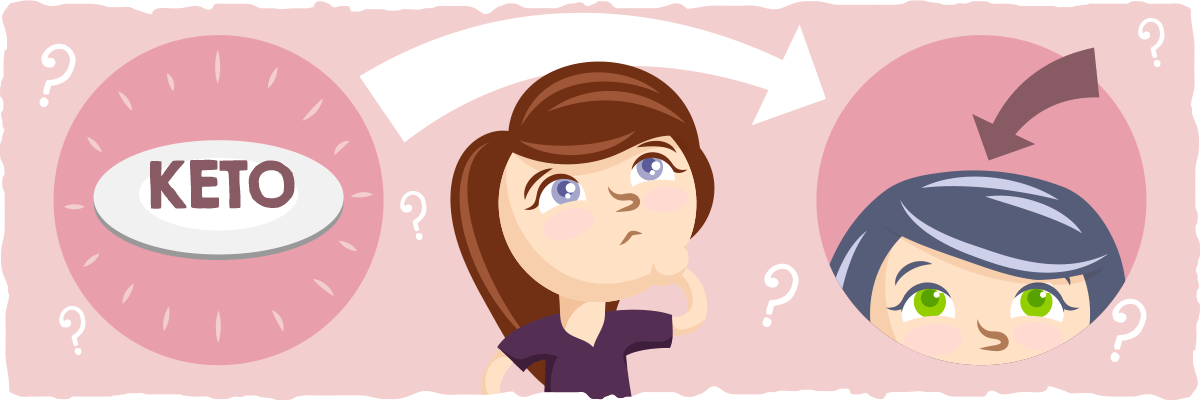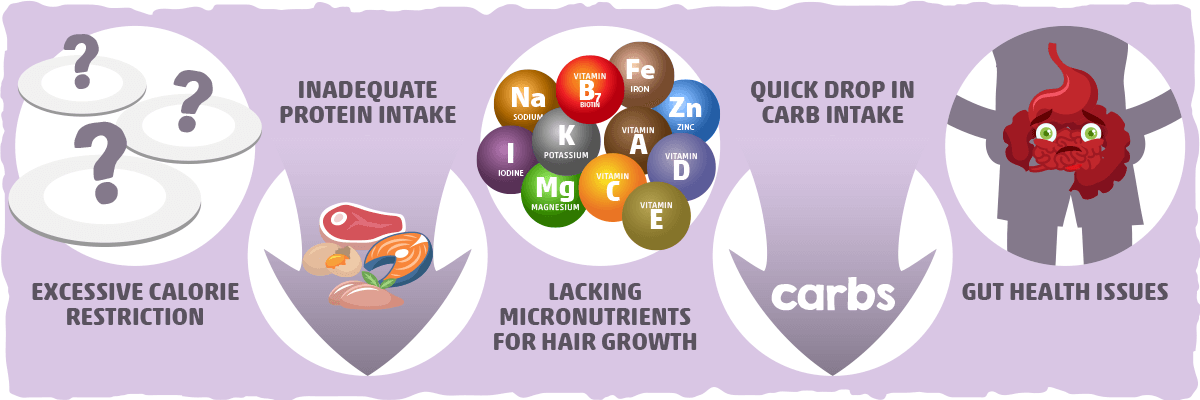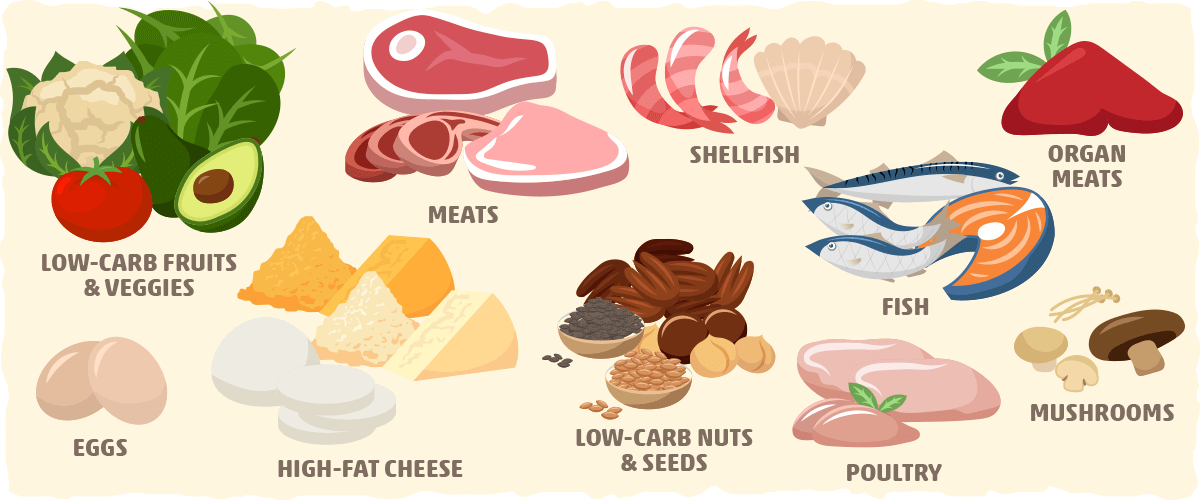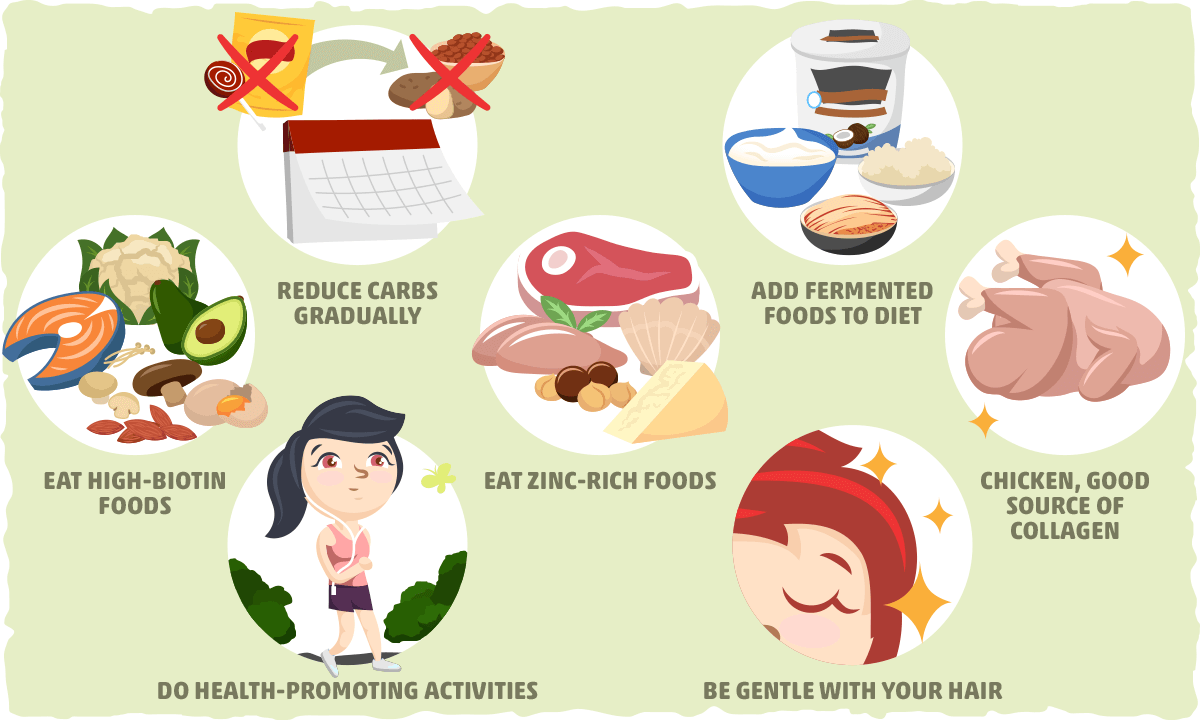What do a keto dieter, raw vegan, and backpacker have in common? If they don’t eat enough, their hair may start falling out.
In other words, keto doesn’t cause hair loss directly. Instead, it is the significant shift in what and how much we eat that can cause us to lose hair. Fortunately, there is a simple solution that’ll help your hair regrow just as thick as before: eating more of the right keto foods. (Plus, you can even prevent hair loss with the same strategies!)
To help you stay on keto and lose body fat without losing your hair as well, let’s take a closer look at each crucial aspect of hair health.
The Process of Hair Growth and What Causes Hair Loss
Though the part of our hair we can touch is mostly composed of inert protein fibers, there is a lot going on underneath the surface of our skin to create this strong tissue we call hair.
In general, the anatomy of our hair can be simplified into two fundamental structures:
- The follicle — Residing deep in your skin, the follicle is where hair growth starts (or stops) in response to the nourishment and chemical messages it receives from the body.
- The shaft — This is the part of the hair that you can touch. It is made primarily of a protein called keratin, which is compacted and fused together.
Whether or not your hair grows, falls out, or grows back is determined by the hair growth phase your follicles are in:
- Anagen phase — This is when hair growth happens. During this phase, the hair grows about 1 cm every 28 days, pushing the old hair up and out of the follicle. The length of each anagen phase depends on where the hair follicle is. For example, scalp hair typically stays in this phase for two to six years.
- Catagen phase — A transitional stage where growth stops, lasting two to three weeks.
- Telogen phase — Also known as the resting phase, this is when growth completely stops for up to 100 days. Around 6% to 8% of all hairs are in this phase while the rest is growing. Typically, 25 to 100 telogen hairs are shed each day.
Though each hair follicle will cycle through these phases throughout life, the number of hair follicles in a specific phase will vary based on various lifestyle factors.
Significant increases in stress, for example, can cause a greater percentage of follicles to shift into the telogen phase. This eventually leads to the shedding of more hair than usual.
Simply put, excess stress means more hair loss.
Does Keto Cause Hair Loss?
One often overlooked cause of stress that can lead to hair loss is making a major diet change.
In many cases, following a new diet requires us to eliminate certain types of foods, which increases the likelihood that we don’t eat enough calories, protein, or specific micronutrients to support optimal health. This forces your body to prioritize the function of your vital organs over hair growth.
If the stress from inadequate nutrition continues, more hair follicles will shift into the telogen (resting) phase and hair shedding will soon increase (but it may take several months before you notice substantial increases in hair loss).
Put in another way; if your diet is deficient, this can cause excess stress that leads to hair loss. (This is why backpackers, keto dieters, and raw vegans can all struggle with hair loss, regardless of how different their diets may look.)
To keep this from happening or promote hair regrowth, we must address the following keto hair loss culprits:
- Inadequate calorie intake
- Eating too little protein
- Lacking key vitamins and minerals for hair growth
- Abrupt carb restriction
- Gut health issues
Common Keto Hair Loss Cause #1: Excessive Calorie Restriction
Studies have found that rapid weight loss can cause hair loss. When you substantially reduce your calorie intake, your body responds by making sure the available energy goes to the most important functions first.
At the level of the hair follicle, a process called telogen effluvium will take place, which is when more follicles shift from growing to resting. On the keto diet, this typically occurs when people don’t replace the calories they would usually get from high-carb foods with healthy fats and protein.
One simple way to keep keto from thinning your hair is by following a personalized keto meal plan that is designed for steady fat loss rather than rapid drops in weight. We’ll take a closer look at how to accomplish this after addressing the remaining causes of hair loss on keto.
Common Keto Hair Loss Cause #2: Inadequate Protein Intake
A popular keto concern is that eating too much protein will keep us from ketosis. This often influences keto dieters to limit their protein intake before learning that “too much protein” means much more than most of us would expect.
In fact, even those who are on a carnivore diet can easily maintain ketosis despite eating high-protein meals all day.
Furthermore, the downsides of eating too little protein far outweigh what might happen when we eat too much. Compared to a moderate-protein keto diet, someone who limits protein intake may lose the same amount of weight, but much more of it will come from their muscle and hair.
If inadequate protein intake is then added to a diet that restricts calories excessively, muscle and hair loss will be accelerated and compounded. In fact, one study on nutrient deficiencies and hair found that severe calorie deficits and low protein intake were the two main factors responsible for hair loss.
Common Keto Hair Loss Cause #3: Lacking Micronutrients for Hair Growth
When we change the foods we eat, this may also lead to vitamin and/or mineral deficiencies. As with any function in your body, your hair follicles need key vitamins and minerals for optimal function.
To reduce the risk of hair loss, make sure you are consuming foods that provide you with plenty of biotin, iron, zinc, and vitamins A, C, D, and E.
It is also crucial to replenish the minerals your body excretes as it adapts to keto. This includes sodium, magnesium, potassium, and iodine.
The simplest way to prevent vitamin and mineral deficiencies on keto is with a minimally-processed keto diet that features fresh seafood, fresh meat/poultry, eggs, low-carb vegetables, avocado, high-fat cheese, and keto nuts/seeds.
Common Keto Hair Loss Cause #4: Quick Drop in Carb Intake
As you cut carbs and you shift into ketosis, your body will start using more fat and ketones, instead of carbohydrates, for fuel. Due to a concept known as metabolic flexibility, the transition from carbs to fat can vary significantly from person to person.
Some of us, for example, experience a relatively smooth transition into ketosis, while others will struggle through flu-like symptoms, fatigue, and increased stress levels.
Often, the transition to ketosis will be eased by addressing the previous three keto hair loss culprits. However, if going strict keto is still too stressful for your body, then you may need to decrease carb intake at a slower pace.
Common Keto Hair Loss Cause #5: Gut Health Issues
Your gut health directly affects every system in your body, including your hair, skin, and nails. If you are struggling with gut issues, it can increase overall stress levels and cause your follicles to put hair growth on hold.
Furthermore, recent research in mice has found that an unhealthy gut microbiome can prevent the production of key hair health nutrients, particularly biotin. As a result, mice that were fed a biotin-deficient diet experienced substantial amounts of hair loss.
Since the human gut microbiome also synthesizes biotin (along with thiamine, folate, riboflavin, pantothenic acid, and Vitamin K), this finding demonstrates the importance of taking care of our gut microbiome, especially as we adopt a new diet.
The Keto Hair Loss Solution: 3 Steps to Fix or Prevent Hair Loss
Although there are five common hair loss culprits, it will not be necessary to apply five separate solutions to resolve each one. In fact, all it takes is three simple steps to address them:
- Calculate and track your keto macros.
- Eat more micronutrient-rich keto foods.
- Transition to ketosis carefully with the help of the right foods, supplements, and strategies.
Step 1: Calculate and Track Your Macros As You Adapt to Keto
With this step, you can address the top two causes of hair loss on keto: Inadequate calorie and protein intake.
To figure out what you should aim for, plug your info into our keto calculator. This will help you establish a baseline to start from.
In general, it is best to stay within the range of a 5-30% calorie deficit. If you have lower body fat levels (or only a few pounds to lose), aim for a lower deficit to prevent muscle and hair loss.
When it comes to protein intake, you can either follow the numbers you get from the keto calculator or figure out your daily limit with these guidelines:
- If you are sedentary — consume 0.6 – 0.8g of protein per pound of lean body mass.
- If you are regularly active — have 0.8 – 1.0g of protein per pound of lean body mass.
- If you lift weights — eat 1.0 – 1.2g of protein per pound of lean body mass.
To decrease the likelihood that you’ll lose hair and muscle mass, it is best to shoot for the higher end of these protein intake ranges.
Once you’re equipped with your keto macros, track what you eat using a keto-friendly tracking app to make sure you are hitting your macro goals and minimizing your risk of hair loss. (If you need help configuring the app for keto, follow the steps in our guide to macro tracking.)
During your first week of keto, you may lose 2 to 10 pounds of water weight. Make sure you are drinking plenty of water with electrolytes during this time.
After your initial drop in water weight, aim for a slow and steady weight loss rate of 1-2 pounds per week. This gentle decrease in weight will minimize the stress that following a new diet places on the body.
Step 2: Eat Mostly Micronutrient-rich Keto Foods
To reduce the risk of hair loss, we must meet our vitamin and mineral needs as well. More specifically, make sure you are adding natural sources of biotin, iron, zinc, and vitamins A, C, D, & E to your keto meals.
Not only will this address any micronutrient deficiencies that can contribute to hair loss, but you will improve gut health and your ability to adapt to keto as well (i.e., the fourth and fifth keto hair loss culprits).
Simply put, eat more minimally-processed low-carb foods. This includes:
- Meat — Fresh cuts of beef, lamb, and pork are a great source of keto-friendly protein, zinc, iron, and b-vitamins.
- Organ meats — The most nutrient-dense of the organ meats is beef liver, which is one of the best sources of vitamin A, iron, copper, and biotin on keto.
- Fish — Not only is fresh fish filled with healthy fat and protein, but it provides us with a good source of vitamin D, zinc, iodine, iron, magnesium, and potassium. Wild-caught sardines, mackerel, and salmon are typically the most nutrient-rich options.
- Shellfish — Most shellfish are packed with essential hair health minerals, including zinc and iron.
- Poultry — Need help with increasing your protein and zinc intake on keto? Add in more chicken and turkey.
- Eggs — While the egg white is a great source of protein for keto, the yolk serves as a low-dose multivitamin, providing us with a good source of biotin, vitamin A, and vitamin D, along with ten other essential vitamins and minerals. Simply put, eggs will benefit your overall health, from your hair follicles to your bones.
- Low carb fruits and vegetables — Leafy greens, cruciferous veggies, herbs, tomatoes, and avocado are low-carb plant foods that’ll help cover most of your remaining hair-growth nutrient needs. By adding them to your keto meals, you’ll get plenty of vitamin C, biotin, and vitamin E, along with a plethora of electrolytes and antioxidants. Along with that, you’ll be feeding the good bacteria in your gut and supporting gut health as well.
- Low-carb nuts and seeds — As with keto-friendly fruit and vegetables, nuts and seeds are packed with a variety of vitamins, minerals, and antioxidants that are relatively sparse in meat and seafood. Keto-friendly nuts and seeds, in particular, provide us with one of the best natural sources of vitamin E and biotin.
- High-fat cheese — Cheese makes every dish better by boosting its flavor and health benefits. Adding extra cheese is one of the easiest ways to ensure you get plenty of fat, protein, vitamin A, and zinc with your keto meal.
- Mushrooms — Turn them into pizza crust, use them as a keto bun, or toss some of your favorite mushrooms into your keto meal for extra zinc, biotin, and vitamin D.
With this keto food list in mind, we can now bring steps 1 and 2 together: Meet your calorie and protein needs with micronutrient-rich keto-friendly foods (and you will get the results you want without losing your hair over it).
For some of us, however, implementing these steps may not be enough to mitigate hair loss entirely. In this case, we must take extra precautions (with step 3) to make the keto transition as easy on the body as possible.
Step 3: Adapt to Ketosis Carefully with the Right Foods, Supplements, and Strategies
This step will help address any remaining gaps in your keto diet, easing your body’s transition into ketosis.
Keto Supplements to Consider:
- Electrolytes — When we significantly reduce our carb intake, we tend to lose fluid and electrolytes rapidly. If you don’t replenish these lost minerals, you may experience hair loss and flu-like symptoms (which are known as the keto flu). While you are transitioning to keto eating, make sure to increase your intake of key electrolytes, particularly sodium, potassium, and magnesium. For more in-depth recommendations, check out our article on how to remedy the keto flu.
- MCT oil — MCTs are a type of fat that can be rapidly converted into ketones in the liver. This can help improve our ability to adapt to keto. To find the right MCT supplement for you, read through our guide to MCT oil.
- Collagen — Whether it’s coming from a collagen protein supplement, bone broth, chicken skin, or pork rinds, make sure you get a daily dose of this protein. Not only will it improve the health of your skin, hair, and nails, but it can help improve gut health and sleep quality as well. To learn more, check out our guide to collagen on keto.
- Vitamin D3 — If you aren’t able to get adequate sun exposure, vitamin D3 supplementation will help ensure optimal health. For most people, taking 1,000-2,000IU of D3 per day is sufficient.
- Coconut oil — A 2018 review of coconut oil studies discovered that topical coconut oil may help prevent hair damage. Try gently massaging some into your scalp as a way to provide nourishment directly to the follicle.
Keto Strategies and Medicinal Foods:
- Reduce carb intake little by little — If going from high-carb eating to strict keto is too stressful for your body, then try taking the slow and steady approach to keto instead. Start by cutting out processed high-carb foods like chips and candy for 1-2 months, then progress to grains, followed by beans, potatoes, and so on. Replace those high-carb foods with the keto foods from the list under step 2. After several months, you’ll likely find yourself in ketosis without having to struggle through a difficult keto transition.
- Add fermented foods to your meals — Sauerkraut, kimchi, sugar-free coconut yogurt, and other fermented low-carb foods provide us with the easiest and cheapest way to add probiotics and other gut health-promoting nutrients to our keto diet.
- Eat high-biotin foods each day — Biotin is essential for hair, skin, and nail health, but it likely won’t be necessary for you to supplement with it on keto. As long as you include a few of the following foods into your daily diet, you should be able to meet your biotin needs: Cauliflower, whole eggs, salmon, almonds, avocados, spinach, mushrooms, or high-fat dairy.
- Don’t forget the zinc-rich foods — This essential mineral plays a crucial role in hair tissue growth and repair. On keto, red meat and poultry will provide the majority of zinc. Other good sources include low-carb nuts, shellfish, and high-fat dairy.
- Eat the skin and make your own broth — These are two of the cheapest natural sources of collagen. A simple way to save big on meals and supplements is by buying a whole chicken, eating the skin, and using the leftover parts to make your own bone broth.
- Add other health-promoting activities to your keto lifestyle — Meditation, brisk walks, hiking, yoga, and other stress-reducing activities will help you keep stress levels under control, so you don’t lose your hair over keto, literally and metaphorically.
- Be gentle with your hair as you adapt to keto — As you adjust to keto dieting, make sure to use a gentle shampoo and a moisturizing conditioner. It is also best to avoid harsh formulas, chemical treatments, tight braids/ponytails, and excessive heat exposure.
Key Takeaways: Keto Hair Loss, the Three-step Solution, and How to Prevent It
Any significant increase in stress can cause our hair to fall out. A common cause of stress-induced hair loss is implementing a restrictive diet.
Though keto isn’t directly to blame for thinning hair, transitioning to the diet can increase the likelihood that the following five hair loss culprits occur:
- Severe calorie restriction
- Inadequate protein intake
- Micronutrient deficiency
- An abrupt drop in carbs
- Gut health issues
Fortunately, these five causes of hair loss can be addressed with three simple steps:
- Calculate and track your keto macros.
- Eat more micronutrient-rich keto foods.
- Adapt to ketosis carefully with the help of the right foods, supplements, and strategies.
With the help of these steps, you will be able to address the cause of keto hair loss at the root, preventing further thinning and stimulating growth.
Sources















